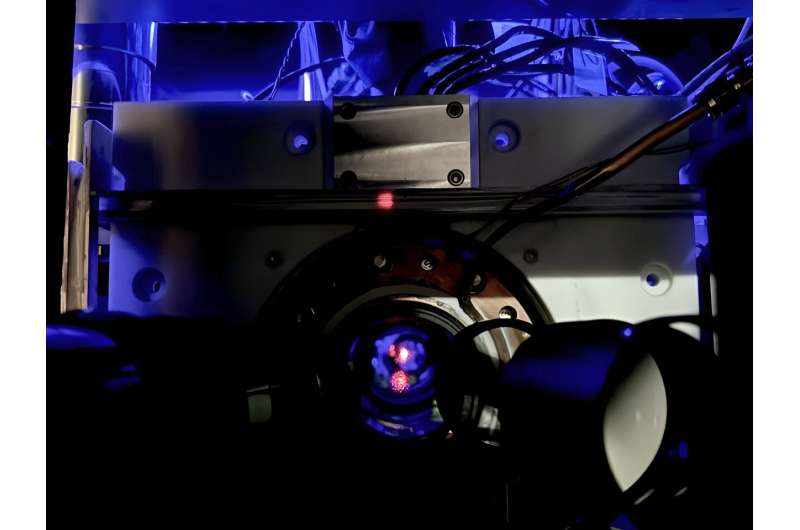
An extremely cold gas of strontium atoms is trapped in a lattice of light called an optical lattice. The atoms are held in an ultra-high vacuum environment, meaning there is almost no air or other gases present. This vacuum helps preserve the atoms’ delicate quantum states, which are fragile. The red dot you see in the image is a reflection of the laser light used to create the atom trap. Credit: K. Palubicki/NIST
In humanity’s relentless quest for perfection, scientists have developed an atomic clock that is more precise and accurate than any clock ever created. The new clock was built by researchers at JILA, a joint institution of the National Institute of Standards and Technology (NIST) and the University of Colorado Boulder.
Enabling precise navigation in the vastness of space as well as the search for new particles, this clock is the latest to go beyond simple timekeeping. With their increased precision, these next-generation clocks could reveal hidden underground mineral deposits and test fundamental theories such as general relativity with unprecedented rigor.
For atomic clock architects, it’s not just about building a better clock; it’s about unlocking the secrets of the universe and paving the way for technologies that will shape our world for generations to come.
The global scientific community is considering redefining the second, the international unit of time, using these next-generation optical atomic clocks. Current-generation atomic clocks shine microwaves on atoms to measure the second. This new wave of clocks illuminates atoms with visible light waves, which have a much higher frequency, to count the second with much greater precision.
Compared to current microwave clocks, optical clocks are expected to offer much higher accuracy for international timekeeping, potentially losing only one second every 30 billion years.
But before these atomic clocks can operate with such precision, they must have very high accuracy; in other words, they must be able to measure extremely small fractions of a second. Achieving both high precision and high accuracy could have vast implications.
Stuck in time
The new JILA clock uses a lattice of light called an optical lattice to simultaneously trap and measure tens of thousands of individual atoms. Having such a large array offers a huge advantage in terms of precision. The more atoms measured, the more data the clock has to provide a measurement accurate to the second.
To achieve new performance records, JILA researchers used a shallower, softer “grating” of laser light to trap atoms, compared with previous optical lattice clocks. This significantly reduced two major sources of error: the effects of laser light trapping atoms and atoms colliding with each other when packed too tightly.
The researchers describe their progress in a paper that has been accepted for publication in Physical Exam Letters. The work is currently available on the arXiv preprint server.
Timing relativity at the smallest scales
“This clock is so precise that it can detect tiny effects predicted by theories such as general relativity, even at the microscopic scale,” said Jun Ye, a physicist at NIST and JILA. “It pushes the boundaries of what is possible in timekeeping.”
General relativity is Einstein’s theory that describes how gravity is caused by the warping of space and time. One of the main predictions of general relativity is that time itself is affected by gravity: the stronger the gravitational field, the slower time passes.
This new clock design can detect relativistic effects on timekeeping at the submillimeter scale, about the thickness of a human hair. By simply raising or lowering the clock by this tiny distance, researchers can discern a tiny change in the flow of time caused by the effects of gravity.
This ability to observe the effects of general relativity at the microscopic scale can significantly bridge the gap between the microscopic quantum realm and the large-scale phenomena described by general relativity.
Space navigation and quantum advances
More accurate atomic clocks also allow for more precise navigation and exploration in space. As humans venture further into the solar system, clocks will need to keep accurate time over vast distances. Even tiny errors in timing can lead to navigation errors that increase exponentially the further you travel.
“If we want to land a spacecraft on Mars with extreme precision, we will need clocks with much higher precision than we have today with GPS,” Ye said. “This new clock is a major step toward achieving that goal.”
The same methods used to trap and control atoms could also lead to major advances in quantum computing. Quantum computers must be able to precisely manipulate the internal properties of individual atoms or molecules to perform calculations. Advances in controlling and measuring microscopic quantum systems have greatly advanced this endeavor.
By venturing into the microscopic realm where the theories of quantum mechanics and general relativity intersect, researchers are opening the door to new levels of understanding the fundamental nature of reality itself. From infinitesimal scales where the flow of time is distorted by gravity, to vast cosmic frontiers where dark matter and dark energy reign, the exquisite precision of this clock promises to illuminate some of the deepest mysteries of the universe.
“We’re exploring the frontiers of measurement science,” Ye said. “When you can measure things with this level of precision, you start to see phenomena that we’ve only been able to theorize about until now.”
More information:
Alexander Aeppli et al, A clock with 8×10−19 systematic uncertainty, arXiv (2024). DOI: 10.48550/arxiv.2403.10664
Provided by the National Institute of Standards and Technology
This article is republished with kind permission from NIST. Read the original article here.
Quote:World’s most accurate and precise atomic clock pushes boundaries of physics (2024, July 1) retrieved July 1, 2024 from https://phys.org/news/2024-07-world-accurate-precise-atomic-clock.html
This document is subject to copyright. Apart from any fair dealing for the purpose of private study or research, no part may be reproduced without written permission. The content is provided for informational purposes only.